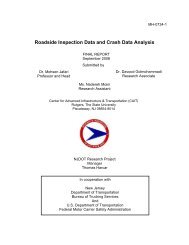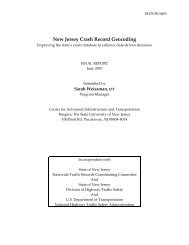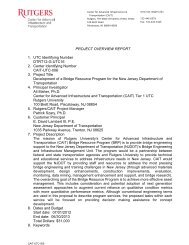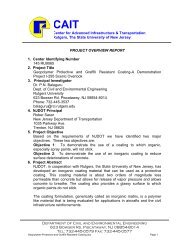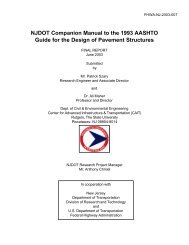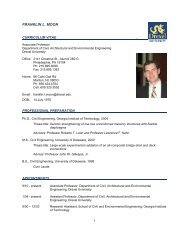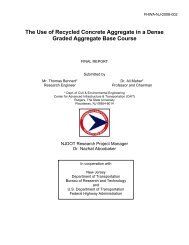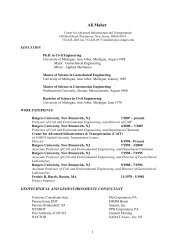Short Line Rail: Its Role in Intermodalism and Distribution
Short Line Rail: Its Role in Intermodalism and Distribution
Short Line Rail: Its Role in Intermodalism and Distribution
You also want an ePaper? Increase the reach of your titles
YUMPU automatically turns print PDFs into web optimized ePapers that Google loves.
completeness. Regardless of the measures chosen, what is clear is that freight traffic<br />
has grown enormously over the years, <strong>and</strong> more importantly, trucks have become the<br />
primary mover of freight nationally.<br />
The ton-mile metric is the primary physical measure of freight transportation output, as it<br />
addresses both weight <strong>and</strong> distances covered <strong>in</strong> freight h<strong>and</strong>l<strong>in</strong>g. As Dennis (2007)<br />
states, national estimates of ton-miles have been developed by various organizations<br />
over the years. These estimates have differed <strong>in</strong> coverage <strong>and</strong> reliability. The U.S.<br />
Bureau of Transportation Statistics (BTS) has worked to improve basic measures of<br />
transportation activity, <strong>in</strong>clud<strong>in</strong>g ton-miles. Various BTS estimates for air, truck, rail,<br />
water, <strong>and</strong> pipel<strong>in</strong>es are used for the follow<strong>in</strong>g tables. 1<br />
Table 4.1 clearly shows the overall <strong>in</strong>crease <strong>in</strong> the ton-miles of freight traffic <strong>in</strong> the<br />
United States post-war. This <strong>in</strong>crease parallels the growth <strong>in</strong> population <strong>and</strong> the<br />
economy dur<strong>in</strong>g that period. What is also clear is the dramatic <strong>in</strong>crease <strong>in</strong> both truck<br />
<strong>and</strong> air freight. The former correspond<strong>in</strong>g to the development of the Interstate Highway<br />
System, beg<strong>in</strong>n<strong>in</strong>g <strong>in</strong> 1955. The latter correspond<strong>in</strong>g to changes <strong>in</strong> the underly<strong>in</strong>g<br />
economy of the Unites States as it shifted more <strong>in</strong>to a service-based economy <strong>and</strong><br />
away from an agricultural <strong>and</strong> extractive <strong>in</strong>dustry economy. Also evident is the <strong>in</strong>crease<br />
<strong>and</strong> then decrease <strong>in</strong> the roles that both domestic water <strong>and</strong> pipel<strong>in</strong>e transportation<br />
have played <strong>in</strong> the movement of freight <strong>and</strong> commodities. However, ton-mile data do<br />
not portray clearly the dramatic shifts that have occurred over that period of time with<br />
regard to modal share.<br />
Table 4.1: U.S. Ton-Miles of Freight – 1960 – 2006<br />
(Millions)<br />
1960 1970 1980 1990 1995 2000 2005 2006<br />
TOTAL U.S. ton-miles of freight<br />
U 2,206,713 3,404,015 3,621,943 4,104,235 4,328,642 4,574,701 4,637,513<br />
Air 553 2,709 4,840 10,420 12,720 15,810 15,741 15,357<br />
Truck 285,000 412,000 629,675 848,779 1,034,041 1,192,825 1,291,515 1,294,492<br />
<strong>Rail</strong>road 572,309 764,809 932,000 1,064,408 1,317,010 1,546,319 1,733,777 1,852,833<br />
Domestic water transportation U<br />
596,195 921,835 833,544 807,728 645,799 591,276 561,629<br />
Pipel<strong>in</strong>e 229.000 431,000 915,666 864,792 932,737 927,889 942,392 913,202<br />
Oil & Oil Products U U 588,000 584,100 601,100 577,000 607,500 584,700<br />
Natural Gas U U 327,666 280,692 331,637 350,889 334,892 328,502<br />
NOTES: BTS is develop<strong>in</strong>g more comprehensive <strong>and</strong> reliable estimates of ton-miles for the air, truck, rail, water, <strong>and</strong> pipel<strong>in</strong>e modes<br />
than are presented <strong>in</strong> table 1-46a. These improved estimates are not comparable to data <strong>in</strong> table 1-46a. Improved estimates for<br />
1960-1989, which will allow more comprehensive <strong>and</strong> reliable data for the entire period from 1960 to present, are still under<br />
development <strong>and</strong> will be reported when they are completed.<br />
Numbers may not add to totals due to round<strong>in</strong>g.<br />
SOURCE: U.S. Department of Transportation, Bureau of Transportation Statistics, special tabulation.<br />
While not provid<strong>in</strong>g an historical picture of the change <strong>in</strong> modal share of freight h<strong>and</strong>led<br />
<strong>in</strong> the U.S., Table 4.2 does dramatically illustrate the role truck<strong>in</strong>g plays <strong>in</strong> the<br />
1 Fuller coverage is achieved by comb<strong>in</strong><strong>in</strong>g reported data from established sources, estimates from surveys, <strong>and</strong> calculations based<br />
on certa<strong>in</strong> assumptions. For more <strong>in</strong>formation on the improved approach, <strong>in</strong>clud<strong>in</strong>g discussion of data sources <strong>and</strong> methods used,<br />
visit the BTS web site at www.bts.gov, <strong>and</strong> use the search eng<strong>in</strong>e to f<strong>in</strong>d improved estimates of ton-miles.<br />
41



